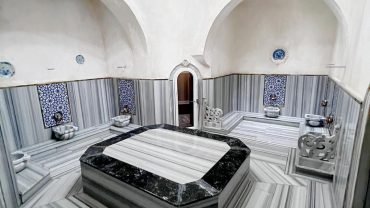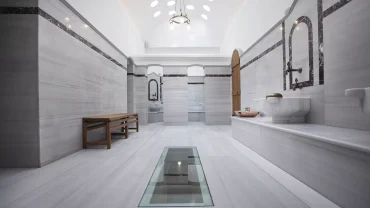
The history of Turkish baths, also known as hammams, is a one-of-a-kind experience that dates back to ancient times. These bathhouses have played a significant role in Ottoman culture and continue to be a celebrated and practiced tradition in Turkey today. In this article, we aim to introduce you to the origins, evolution, and cultural significance of Turkish hammams, exploring how they have shaped and been shaped by history even today.
The Origins of Turkish Hammams
The origins of Turkish hammams can be followed back to glorious ancient Roman and Byzantine bathhouses. The Ottoman people, upon their conquest of Byzantine territories, adopted these bathing traditions and made them regular practices by adapting them to fit Islamic customs and hygiene practices.
That led to the born of the Turkish hammam, a unique blend of ancient bathing practices and Ottoman cultural elements.
Key Features of Historical Turkish Bathhouses
Historical Turkish bathhouses, or hammams, are easily recognizable as they have common unique architectural features:
- Domed Ceilings: These ceiling type allows steam to circulate efficiently inside the facility, creating the ideal atmosphere for bathing.
- Marble Interiors: Marble helps maintain the heat and provides a luxurious feel. That is an indispensable part of a Turkish bath.
- Kurna: Basins used for pouring water over oneself.
- Gobek Tasi: It is the central marble stone that is heated where bathers lie to be scrubbed and massaged. Gobek Tasi is also an important element of Turkish hammam history.
Evolution Through the Ages
The evolution of hammam traditions goes hand to hand with the evolution of Turkish society. While the main elements of the hammam experience survived until this date, there have been some changes over the centuries. Modern Turkish hammams blend traditional practices with up-to-date spa treatments, to offer a more comfortable and relaxing experience to both locals and tourists.
Traditional Rituals and Practices
Let us give you a short insight to the Turkish hammam experience. It involves a few steps:
- Warming Up: Visitors begin to the experience in a warm room to start sweating. That will help to open pores and soften the skin.
- Scrubbing: A special mitt called “kese” is used to exfoliate the skin. That is to get rid of the dead skin
- Foam Massage: That can be the most relaxing part of the whole experience
- Rinsing: Bathers rinse themselves with warm water to clean up before the last step.
- Relaxation: The experience ends with relaxation in a cooler room. Here you can enjoy some traditional refreshments to cool off.
Cultural Significance of Ottoman Hammam Culture
The Ottoman hammam culture is not only about bathing, it is a reflection of culture and life style. Hammams were social hubs where people gathered to relax, spend time, and celebrate special occasions. These bathhouses played an important role in community life, hosting events such as weddings, circumcisions, and other social gatherings.
Turkish Hammam Culture Today
Today, Turkish hammams are still an inseparable part of Turkish culture. While some hammams have been modernized to become more satisfying to their visitors, offering luxurious spa experiences; many traditional bathhouses in Istanbul still provide an authentic cultural experience. That provides a look into the history and culture of the city.
The Benefits of Turkish Hammams
The history of Turkish baths is not only a cultural legacy; but it also offers many health benefits. Regular visits to a hammam can improve circulation, detoxify the body, and provide deep relaxation. Both your body and your soul will heal with this experience. The heat and steam open up pores, allowing for deep cleansing, while the scrubbing process exfoliates the dead skin and gives you a baby-soft skin.
Health and Wellness Benefits
Regular hammam visits can be beneficial in many ways. Here are some examples to its wellness results:
- Skin Health: Regular exfoliation helps remove dead skin cells and soften your skin.
- Relaxation: The heat and steam help reduce stress.
- Detoxification: Sweating helps remove toxins from the body.
The Role of Historical Turkish Bathhouses in Modern Society
The historical Turkish bathhouses even today plays an essential role in modern Turkish life style. They are one of the most iconic elements of country’s rich cultural heritage and they provide a unique harmony of history, culture, and wellness. Whether you are looking for an experience of relaxation or a cultural adventure, Turkish hammams offer a matchless journey to combine both.
Preserving the Tradition
It is not an easy task to keep up with the historical practices in modern times. Endless efforts are being made to preserve traditional hammams and their unique cultural practices. Because they are the reminders of a glorious culture.
Many historical bathhouses in Istanbul have been restored and continue to operate, offering both locals and tourists a unforgettable journey into the past.
The Influence of Turkish Hammams on Modern Spas
The design and rituals of Turkish hammams have inspired even influenced modern spa culture around the world. Many modern day spas have elements of the traditional hammam experience, such as steam rooms, exfoliation treatments, and foam massages. This blend of ancient and modern practices offers a unique wellness experience.
Global Spread of the Hammam Tradition
- Middle East and North Africa: Turkish hammams inspired similar bathhouses across the region. Hammam culture is also an important part of daily life here.
- Europe: The concept of steam baths and public bathing spread to Europe, influencing the development of saunas and steam rooms.
- North America: Modern spas in the United States and Canada often feature hammam-inspired treatments.
Famous Hammams Around the World
In addition to Istanbul’s historic hammams, several famous hammams can be found around the World that may be inspired by Turkish hammam culture and facilities. These bathhouses have preserved traditional practices while adapting to local cultures.
- Hammam al-Andalus, Spain: Reflecting the influence of Islamic culture in Spain, these bathhouses offer a blend of Moroccan and Turkish bathing traditions.
- Hammam de la Mosquée de Paris, France: A beautiful example of North African hammam culture in the heart of Paris.
- King’s Bath (Kiraly Bath), Hungary: While not a Turkish hammam itself, the influence of Ottoman bathing practices can be seen in Budapest’s famous thermal baths.
Hammams in Turkish Literature and Cinema
As they have such unique architecture and atmosphere, Turkish hammams are amazing attractions and they have also made their mark in literature and cinema, often serving as a background for the scenes.
Literature
- Orhan Pamuk’s “My Name is Red”: Features scenes set in traditional hammams, highlighting their importance in Ottoman society. Orhan Pamuk is a Nobel Literature prize winner and he is a great representer and storyteller, providing historical and cultural insights about Turkish and Ottoman heritages.
- Elif Shafak’s “The Bastard of Istanbul”: Describes the hammam experience as part of the characters’ daily lives.
Cinema
- “Hamam” (1997): An Italian-Turkish film that explores themes of tradition and modernity through the lens of a hammam in Istanbul.
- “The Water Diviner” (2014): Includes scenes set in hammams, emphasizing their role in Turkish culture.
Modern Efforts to Preserve Traditional Hammams
There are ongoing efforts to preserve the cultural heritage of Turkish hammams. These efforts include restoration projects, cultural events, and educational programs aimed at promoting the traditional hammam experience. Preserving the history and passing it to the next generations are main aims of today’s historians, municipalities and residents.
Restoration Projects
- Suleymaniye Hammam: One of Istanbul’s oldest hammams, has undergone extensive restoration to preserve its historical features.
- Cemberlitas Hammam: Continues to operate as a traditional hammam while offering guided tours to educate visitors about its history.
Cultural Events
- Hammam Festivals: Organized to celebrate the cultural heritage of Turkish bathhouses, featuring traditional music, dance, and food.
- Workshops and Exhibitions: Hosted by museums and cultural institutions to highlight the history and significance of hammams.
The history of Turkish baths is the perfect combination of cultural, social, and health practices that have evolved over centuries. Turkish hammams offer a unique blend of ancient traditions and modern wellness, making them a must-visit for anyone interested in experiencing a unique side of Turkish culture. For more information about traditional bathhouses in Istanbul and to explore our selection of hammam experiences, check out our great options.
Experience the authentic Turkish hammam and discover its rich history. You can check the many different facilities, that are included on our portal and make an instant booking to the one you prefer.






Comment (0)